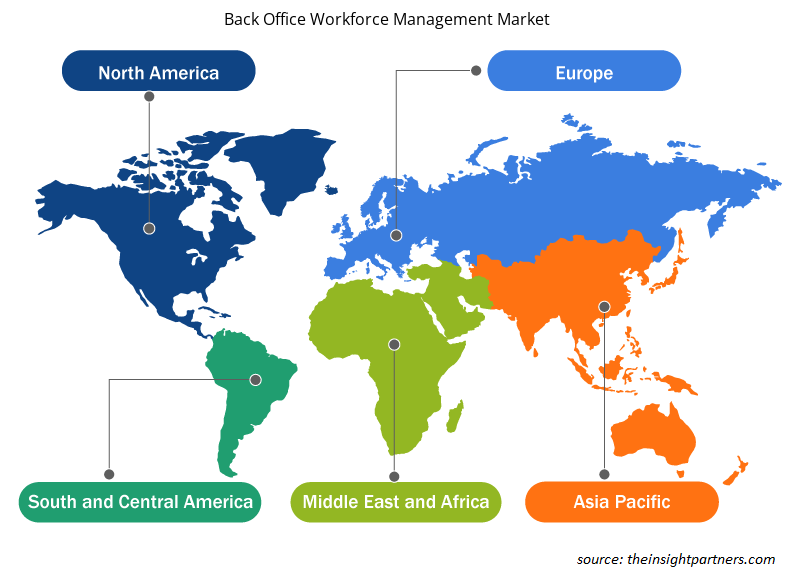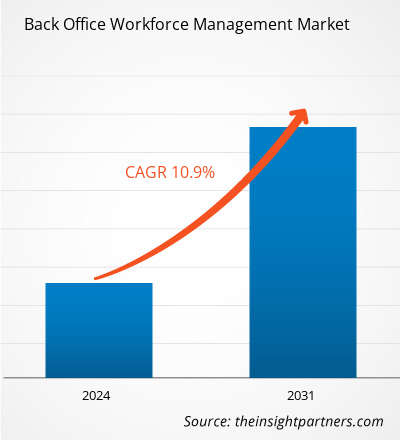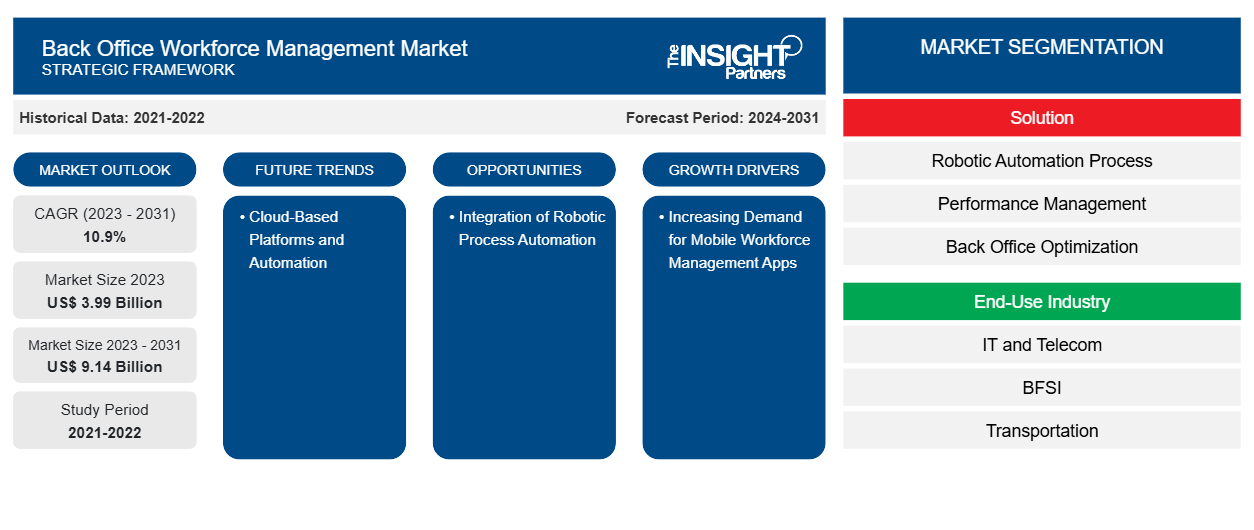Si prevede che la dimensione del mercato della gestione della forza lavoro back office raggiungerà i 9,14 miliardi di dollari entro il 2031, rispetto ai 3,99 miliardi di dollari del 2023. Si prevede che il mercato registrerà un CAGR del 10,9% nel periodo 2023-2031. È probabile che le piattaforme basate su cloud e l'automazione rimangano una tendenza chiave nel mercato.
Analisi di mercato della gestione della forza lavoro di back office
Il mercato della gestione della forza lavoro back office è guidato dalla necessità di ottimizzazione della forza lavoro, crescente distribuzione del cloud e maggiore conformità con diversi mandati normativi. Ancora più importante, la pandemia ha avuto un impatto significativo su questo mercato accelerando rapidamente l'adozione di accordi di lavoro da remoto e flessibili e aumentando notevolmente la domanda di soluzioni che consentano il lavoro da remoto. I principali partecipanti al mercato e l'adozione di mezzi trasparenti e giustificati di sistemi di monitoraggio dei dipendenti agiscono come importanti motori di crescita. Anche gli standard migliorati di gestione della forza lavoro con l'integrazione di nuove tecnologie come IoT e AI stanno pompando il mercato.
Panoramica del mercato della gestione della forza lavoro back office
Back Office Workforce Management si riferisce all'amministrazione e al coordinamento delle operazioni aziendali interne non direttamente associate ai clienti. Comprende enormi funzionalità come contabilità, gestione dell'inventario, gestione della supply chain, risorse umane, logistica e servizi IT, tra molte altre. Il back office svolge un ruolo essenziale nel supportare gli obiettivi e i traguardi del team del front office gestendo attività relative all'amministrazione, alla manutenzione dei record, alla gestione dei dati e così via. Può inoltre comportare una gestione efficace delle risorse, della tecnologia e dei servizi per garantire il corretto flusso dei processi interni dell'organizzazione. Il back office è importante per l'ottimizzazione del carico di lavoro, la soddisfazione dei clienti e dei dipendenti e, infine, per guidare i miglioramenti nelle operazioni.
Personalizza questo report in base alle tue esigenze
Riceverai la personalizzazione gratuita di qualsiasi report, comprese parti di questo report, o analisi a livello nazionale, pacchetto dati Excel, oltre a usufruire di grandi offerte e sconti per start-up e università
-
Scopri le principali tendenze di mercato in questo rapporto.Questo campione GRATUITO includerà analisi di dati che spaziano dalle tendenze di mercato alle stime e alle previsioni.
Driver di mercato e opportunità per la gestione della forza lavoro di back office
Crescente domanda di app per la gestione della forza lavoro mobile
Le aziende stanno sempre più cercando soluzioni basate su applicazioni per gestire la forza lavoro back-office con l'obiettivo di creare ambienti di lavoro intelligenti. Essere preoccupati di assorbire i vantaggi della mobilità costerà molto a lungo termine a causa dell'inefficienza che potrebbe derivarne. A questo proposito, un'applicazione mobile può essere utilizzata per fornire un'unica piattaforma al centro della creazione di un'esperienza coerente in tutta la base di dipendenti connessi. Il monitoraggio della posizione consente alle aziende di fornire contenuti pertinenti e notifiche in tempo reale in tutta la forza lavoro per la creazione di esperienze tempestive e pertinenti che garantiscano efficienza, produttività e coinvolgimento dei dipendenti. Le applicazioni mobili semplificano la registrazione manuale dei giorni di lavoro ufficiali e di tutti gli altri dettagli nel sistema dati. Agisce come un unico luogo attraverso il quale tutti i punti di contatto digitali coinvolti nella gestione di una forza lavoro possono essere integrati senza soluzione di continuità. Il consolidamento delle risorse correlate al lavoro in un'unica app, d'altra parte, consente a un'azienda di gestire il regolare funzionamento dei dipendenti all'interno o all'esterno del posto di lavoro e anche di comunicare e collaborare con i team di gestione e i colleghi. Il crescente riconoscimento dei vantaggi delle soluzioni basate su app mobili per la gestione della forza lavoro crea opportunità per gli operatori del mercato della gestione della forza lavoro back office.touchpoints involved in the management of a workforce can be seamlessly integrated. Consolidation of work-related assets into one app, on the other hand, enables an enterprise to manage the smooth working of employees inside or outside the workplace and also communicate and collaborate with the management teams and coworkers. The growing level of
Integrazione dell'automazione dei processi robotici
Una delle principali tendenze che il mercato probabilmente vedrà è l'incorporazione dell'automazione dei processi robotici nelle soluzioni di gestione della forza lavoro di back office. RPA è definito come un meccanismo che propone di acquisire un numero maggiore di compiti operativi da parte dei robot, il che a sua volta aumenta l'efficienza, la produttività e il coinvolgimento dei dipendenti. La nuova ondata di domanda di automazione delle responsabilità della forza lavoro è un'eccellente opportunità per gli attori coinvolti in questo settore. Può essere utilizzata per potenziare le sue capacità nel soddisfare le nuove aziende che mirano all'ottimizzazione dei processi operativi e delle prestazioni dei dipendenti.RPA is defined as a mechanism that proposes to acquire a bigger number of operational duties by robots, which in turn increases efficiency, productivity, and employee engagement. The new wave of demand for automation of workforce responsibilities is an excellent opportunity for the players involved in this industry. It can be used to gear up its capabilities in catering to new businesses that look toward optimizing operational processes and employee performance.
Analisi della segmentazione del rapporto di mercato sulla gestione della forza lavoro di back office
I segmenti chiave che hanno contribuito alla derivazione dell'analisi di mercato della gestione della forza lavoro back office sono il settore delle soluzioni e quello dell'utente finale.
- In base alla soluzione, il mercato è diviso in processi di automazione robotica, gestione delle prestazioni, ottimizzazione del back office, analisi dei processi e altri. Il segmento della gestione delle prestazioni ha detenuto una quota di mercato significativa nel 2023.
- In base al settore di utilizzo finale, il mercato è segmentato in IT e telecomunicazioni, BFSI, trasporti, vendita al dettaglio ed e-commerce, governo e altri. Il segmento BFSI ha detenuto una quota di mercato significativa nel 2023.BFSI, transportation, retail and e-commerce, government, and others. The BFSI segment held a significant market share in 2023.
Analisi della quota di mercato della gestione della forza lavoro back office per area geografica
L'ambito geografico del rapporto di mercato sulla gestione della forza lavoro nel back office è suddiviso principalmente in cinque regioni: Nord America, Asia Pacifico, Europa, Medio Oriente e Africa, Sud e Centro America.
In Nord America, gli Stati Uniti si distinguono come un mercato cruciale, con un numero considerevole di aziende Fortune 500 con sede nel paese, che guidano la domanda di soluzioni di gestione della forza lavoro di back office. L'adozione di soluzioni di gestione della forza lavoro basate su cloud è in aumento in risposta alla crescente prevalenza di accordi di lavoro da remoto, consentendo alle organizzazioni di monitorare efficacemente gli orari di lavoro e la produttività dei dipendenti che operano da diverse sedi.
Approfondimenti regionali sul mercato della gestione della forza lavoro back office
Le tendenze regionali e i fattori che influenzano il mercato del Back Office Workforce Management durante il periodo di previsione sono stati ampiamente spiegati dagli analisti di Insight Partners. Questa sezione discute anche i segmenti e la geografia del mercato del Back Office Workforce Management in Nord America, Europa, Asia Pacifico, Medio Oriente e Africa e America meridionale e centrale.

- Ottieni i dati specifici regionali per il mercato della gestione della forza lavoro back office
Ambito del rapporto di mercato sulla gestione della forza lavoro di back office
| Attributo del report | Dettagli |
|---|---|
| Dimensioni del mercato nel 2023 | 3,99 miliardi di dollari USA |
| Dimensioni del mercato entro il 2031 | 9,14 miliardi di dollari USA |
| CAGR globale (2023-2031) | 10,9% |
| Dati storici | 2021-2022 |
| Periodo di previsione | 2024-2031 |
| Segmenti coperti |
Per soluzione
|
| Regioni e Paesi coperti |
America del Nord
|
| Leader di mercato e profili aziendali chiave |
|
Operatori del mercato della gestione della forza lavoro del back office Densità: comprendere il suo impatto sulle dinamiche aziendali
Il mercato del Back Office Workforce Management Market sta crescendo rapidamente, spinto dalla crescente domanda degli utenti finali dovuta a fattori quali l'evoluzione delle preferenze dei consumatori, i progressi tecnologici e una maggiore consapevolezza dei vantaggi del prodotto. Con l'aumento della domanda, le aziende stanno ampliando le loro offerte, innovando per soddisfare le esigenze dei consumatori e capitalizzando sulle tendenze emergenti, il che alimenta ulteriormente la crescita del mercato.
La densità degli operatori di mercato si riferisce alla distribuzione di aziende o società che operano in un particolare mercato o settore. Indica quanti concorrenti (operatori di mercato) sono presenti in un dato spazio di mercato in relazione alle sue dimensioni o al valore di mercato totale.
Le principali aziende che operano nel mercato della gestione della forza lavoro back office sono:
- Società anonima NICE Ltd.
- Società di testo aperto
- Società Oracle
- Genesi
- Alvaria, Inc.
- Società anonima Verint Systems, Inc.
Disclaimer : le aziende elencate sopra non sono classificate secondo un ordine particolare.

- Ottieni una panoramica dei principali attori del mercato della gestione della forza lavoro back office
Notizie di mercato e sviluppi recenti sulla gestione della forza lavoro di back office
Il mercato della gestione della forza lavoro back office viene valutato raccogliendo dati qualitativi e quantitativi dopo la ricerca primaria e secondaria, che include importanti pubblicazioni aziendali, dati associativi e database. Di seguito sono elencati alcuni degli sviluppi nel mercato della gestione della forza lavoro back office:
- Zapier, la piattaforma di automazione del flusso di lavoro per piccole e medie imprese, ha annunciato di aver acquisito il team dietro Vowel, uno strumento di videoconferenza basato sull'intelligenza artificiale, per una cifra non divulgata. Il CEO di Vowel, Andrew Berman, diventerà il nuovo direttore dell'intelligenza artificiale di Zapier. Grazie a questa acquisizione, il team di Vowel si concentrerà sul potenziamento delle capacità di automazione dell'intelligenza artificiale di Zapier.
(Fonte: Inter Zapier Inc., sito Web aziendale, marzo 2024)
Copertura e risultati del rapporto di mercato sulla gestione della forza lavoro di back office
Il rapporto "Dimensioni e previsioni del mercato della gestione della forza lavoro back office (2021-2031)" fornisce un'analisi dettagliata del mercato che copre le seguenti aree:
- Dimensioni e previsioni del mercato della gestione della forza lavoro di back office a livello globale, regionale e nazionale per tutti i segmenti di mercato chiave coperti dall'ambito
- Tendenze del mercato della gestione della forza lavoro di back office, nonché dinamiche di mercato quali driver, vincoli e opportunità chiave
- Analisi dettagliata delle cinque forze PEST/Porter e SWOT
- Analisi di mercato della gestione della forza lavoro back office che copre le principali tendenze di mercato, il quadro globale e regionale, i principali attori, le normative e i recenti sviluppi del mercato
- Analisi del panorama industriale e della concorrenza che copre la concentrazione del mercato, l'analisi della mappa di calore, i principali attori e gli sviluppi recenti nel mercato della gestione della forza lavoro back office
- Profili aziendali dettagliati
- Analisi storica (2 anni), anno base, previsione (7 anni) con CAGR
- Analisi PEST e SWOT
- Valore/volume delle dimensioni del mercato - Globale, Regionale, Nazionale
- Industria e panorama competitivo
- Set di dati Excel
Report recenti
Rapporti correlati
Testimonianze
Motivo dell'acquisto
- Processo decisionale informato
- Comprensione delle dinamiche di mercato
- Analisi competitiva
- Analisi dei clienti
- Previsioni di mercato
- Mitigazione del rischio
- Pianificazione strategica
- Giustificazione degli investimenti
- Identificazione dei mercati emergenti
- Miglioramento delle strategie di marketing
- Aumento dell'efficienza operativa
- Allineamento alle tendenze normative























 Ottieni un campione gratuito per - Mercato della gestione della forza lavoro back office
Ottieni un campione gratuito per - Mercato della gestione della forza lavoro back office